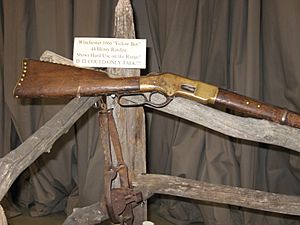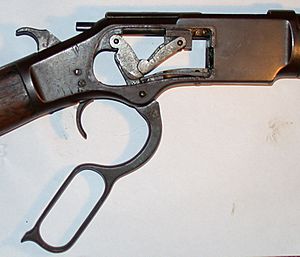Winchester rifle facts for kids
Quick facts for kids Winchester rifle series |
|
|---|---|

Winchester 1873 Rifle
|
|
| Type | Lever-action rifle |
| Place of origin | United States |
| Service history | |
| In service | 1866–1945 (U.S) |
| Used by | United States Canada Japan Chile Mexico Ottoman Empire South Africa Morocco |
| Wars | American Indian Wars Japanese invasion of Taiwan Russo-Turkish War (1877–1878) War of the Pacific North-West Rebellion French intervention in Mexico Spanish–American War Boxer Rebellion Second Boer War Mexican Revolution World War I Spanish Civil War World War II Indonesian National Revolution Uprising of 1953 in East Germany |
| Production history | |
| Designed | 1866 |
| Manufacturer | Winchester Repeating Arms Company |
| Produced | 1866–present |
| No. built | c. 720,000 |
| Variants | Full-stocked "Musket", Carbine, Sporting model |
| Specifications | |
| Mass | 9.5 lb (4.3 kg) |
| Length | 49.3 in (125 cm) |
| Barrel length | 30 in (76 cm) |
|
|
|
| Caliber | .44-40 Winchester .38-40 Winchester .32-20 Winchester .22 Long Rifle |
| Action | Lever action |
| Feed system | tube magazine, 7 to 14 rounds |
| Sights | Graduated rear sights fixed-post front sights |
A Winchester rifle is a type of lever-action repeating rifle made by the Winchester Repeating Arms Company. These rifles were among the first to allow a shooter to fire multiple shots quickly without reloading. They were developed from the 1860 Henry rifle. The Model 1873 was very popular, and the company called it "The Gun That Won the West."
Contents
How Winchester Rifles Started
The idea for a repeating rifle, which could fire many shots, began in 1848. An inventor named Walter Hunt created a rifle with a tube that held many bullets. This was a new idea, but his rifle was not very strong.
Later, in 1855, Horace Smith and Daniel Wesson (who later started Smith & Wesson) improved on this design. They formed a company called Volcanic Repeating Arms. They also created a new type of bullet called a "metallic rimfire cartridge." This was a big step because it put the bullet, powder, and primer all in one easy-to-use package.
The Volcanic rifle did not sell well because its bullets were not powerful enough. In 1857, a businessman named Oliver Winchester bought the company and renamed it the New Haven Arms Company.
A skilled worker named Benjamin Tyler Henry then improved the rifle and created a much stronger bullet, the .44 Henry cartridge. This led to the Henry rifle in 1860. Many Henry rifles were used by soldiers during the American Civil War. Soldiers from the South even joked that the Henry rifle was "that damned Yankee rifle that they load on Sunday and shoot all week!"
Developing New Models
After the Civil War, Oliver Winchester changed the company name to the Winchester Repeating Arms Company. They made the Henry rifle even better, creating the first Winchester rifle: the Model 1866. It used the same .44 Henry bullet but had a stronger design and a wooden front grip.
In 1873, Winchester released the famous Model 1873. This rifle used a new, more powerful bullet called the .44-40 centerfire cartridge. Later, in 1876, they tried to make an even stronger rifle, the Model 1876, for hunting large animals. However, its design was not strong enough for the most powerful hunting bullets of that time.
Starting in 1883, a brilliant gun designer named John Moses Browning began working with Winchester. He designed many important lever-action rifles and shotguns for them, including the Winchester Model 1886, Model 1892, Model 1894, and Model 1895.
Winchester Lever-Action Rifles
Model 1866
The Winchester Model 1866 was the first rifle to carry the Winchester name. It was nicknamed the "Yellow Boy" because its main body was made of a shiny bronze-like metal. This rifle was known for being tough and for its "repeating rifle" action, which let users fire many shots quickly. It also had a new way to load bullets from the side.
France bought 6,000 Model 1866 rifles during the Franco-Prussian War. The Ottoman Empire bought 45,000 of them in 1870 and 1871. These rifles were used in the Russo-Turkish War (1877–1878). During the Siege of Plevna, Turkish soldiers with these repeating rifles caused many more injuries to their enemies, who only had single-shot rifles. This event made many European countries interested in getting repeating rifles.
The Model 1866 was made and sold until 1899. It remained popular because it was cheaper than newer models.
Model 1873
The Model 1873 was one of Winchester's most successful rifles. It was made from 1873 to 1923 and was known as "The Gun That Won the West." It first used the .44-40 cartridge, which was very popular. Later, it was also made to use .38-40 and .32-20 cartridges. These were also popular handgun bullets, so people could use the same type of ammunition for both their rifle and handgun.
The Model 1873 came in three main types: a rifle, a shorter carbine, and a "musket" (a military-style rifle, not a smoothbore gun). The standard rifle was the most popular. Winchester also made custom rifles with longer barrels or special designs.
To make the Model 1873 even more special, Winchester offered a "One of One Thousand" version starting in 1875. These were rifles with barrels that shot unusually straight. They were marked "One of One Thousand" and cost $100, which was a lot of money back then! A famous 1950 Western movie called Winchester '73 was even based on these special guns.
More than 720,000 Model 1873 rifles were made. Today, new versions are still being made in Italy and Japan. These new rifles are very similar to the originals but have two important safety improvements: a firing pin block (which means the gun won't fire unless the trigger is pulled) and a change to make used bullet casings fly away from the shooter.
In 2014, a very old and weathered Model 1873 was found leaning against a tree in a national park. This "Forgotten Winchester" became famous because no one knew who left it there or why they never came back for it.
Model 1876

The Winchester Model 1876, also called the Centennial Model, was a larger and heavier rifle than the 1866 and 1873 models. It was designed to use more powerful bullets for big-game hunting, like hunting large animals. It was introduced to celebrate America's 100th birthday.
The Model 1876 was known as a strong and powerful hunting rifle. It came in different barrel lengths, including a carbine, an express rifle, a sporting rifle, and a musket. Famous people like Theodore Roosevelt used the Model 1876 for his hunting trips. The Canadian North-West Mounted Police also used this rifle. The Apache warrior Geronimo had a Model 1876 when he surrendered in 1886.
Production of the Model 1876 stopped in 1897 because hunters preferred the newer Model 1886, which could handle even more powerful bullets.
Model 1886
The Model 1886 was designed by John Moses Browning. It had a much stronger action than earlier models, which meant it could use very powerful bullets like the .45-70 Government and the huge .50-110 Express "buffalo" cartridges. This was a goal Winchester had for a long time. In 1935, a slightly changed version of the 1886 was released as the Model 71.
Model 1892
The Model 1892 was designed to be lighter than the Model 1873. It used the same types of bullets as the 1873 but had a stronger action. Over one million Model 1892 rifles were made by Winchester. Even though Winchester stopped making them in 1941, new versions are still made today by companies in Brazil and Italy. Modern versions of the Model 1892 can even use powerful handgun bullets like the .357 Magnum and .44 Magnum. The Winchester '92 was often seen in Hollywood Western movies and TV shows.
Model 1894
The Winchester Model 1894, also designed by John Browning, is the most common Winchester repeating rifle ever made. It was one of the first civilian rifles to use new "smokeless" gunpowder, which made less smoke when fired. The Model 1894 became one of the best-selling hunting rifles of all time, selling over seven million units before production in the U.S. stopped in 2006. In the United States, the Winchester .30-30 version is almost always called a "deer rifle."
Model 1895
The Winchester Model 1895 was special because it was the first Winchester lever-action rifle to load bullets from a box magazine inside the rifle, instead of a tube under the barrel. This allowed it to use pointed military bullets. The Model 1895 was used by armies in the United States, Great Britain, and Imperial Russia. Theodore Roosevelt used a Model 1895 on his safaris in Africa and called it his "medicine gun" for lions.
Model 88
| Winchester Model 88 | |
|---|---|
| Place of origin | United States |
| Production history | |
| Produced | 1955–1973 |
| No. built | Approximately 284,000 |
| Variants | Model 88 Carbine |
| Specifications | |
| Mass | 6.53 lb (2.96 kg) |
| Length | 42.1 in (1,070 mm) |
| Barrel length | 22 in (560 mm) |
|
|
|
| Cartridge | .243 Winchester .284 Winchester .308 Winchester .358 Winchester |
| Feed system | Four or five-round detachable box magazine |
The Model 88 was introduced in 1955. It was different from earlier lever-action rifles because it used a rotating bolt and loaded bullets from a detachable box magazine. This design allowed it to use powerful, modern bullets. The Model 88 was made until 1973 and is the third best-selling lever-action rifle in Winchester's history.
Model 9422
Winchester's Model 9422 came out in 1972. It was designed to look like the classic lever-action rifles, with an exposed hammer and a tube magazine. It was made to shoot .22 Long Rifle and .22 WMR bullets. The 9422 was very reliable and popular around the world. It was often used to teach children how to shoot. Production of this model ended in 2005.
New Production Rifles
In 2013, Winchester brought back the Model 1873. It is now made in Japan by the Miroku Corporation under a license from the Olin company. This new 1873 model is available with different barrel lengths and can use .357 Magnum/.38 Special, .44-40 Winchester, or .45 Colt bullets. It looks almost exactly like the original but has two new safety features: a firing pin block and a change to make used bullet casings eject away from the shooter. The magazine can hold up to fourteen rounds.
See also
 In Spanish: Winchester (arma) para niños
In Spanish: Winchester (arma) para niños




